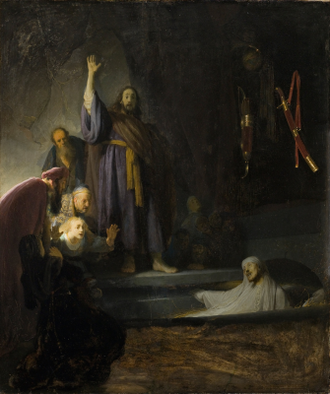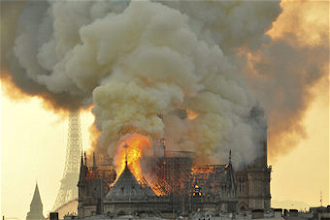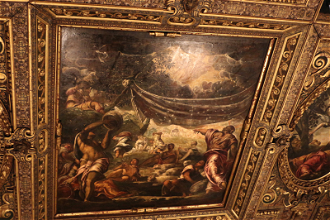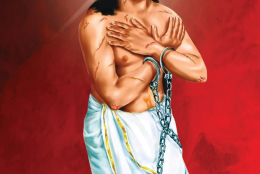Today's Gospel in Art - The Raising of Lazarus

The Raising of Lazarus, by Rembrandt Harmensz. van Rijn, 1630-1632 © Los Angeles County Museum of Art
Gospel of 29th March 2020 - John 11:3-7,17,20-27,33-45
So the sisters sent a message to Jesus, 'Lord, he whom you love is ill.' But when Jesus heard it, he said, 'This illness does not lead to death; rather it is for God's glory, so that the Son of God may be glorified through it.' Accordingly, though Jesus loved Martha and her sister and Lazarus, after having heard that Lazarus was ill, he stayed two days longer in the place where he was.
Then after this he said to the disciples, 'Let us go to Judea again.'
When Jesus arrived, he found that Lazarus had already been in the tomb for four days. When Martha heard that Jesus was coming, she went and met him, while Mary stayed at home. Martha said to Jesus, 'Lord, if you had been here, my brother would not have died. But even now I know that God will give you whatever you ask of him.' Jesus said to her, 'Your brother will rise again.' Martha said to him, 'I know that he will rise again in the resurrection on the last day.' Jesus said to her, 'I am the resurrection and the life. Those who believe in me, even though they die, will live, and everyone who lives and believes in me will never die. Do you believe this?' She said to him, 'Yes, Lord, I believe that you are the Messiah, the Son of God, the one coming into the world.' When Jesus saw her weeping, and the Jews who came with her also weeping, he was greatly disturbed in spirit and deeply moved. He said, 'Where have you laid him?' They said to him, 'Lord, come and see.' Jesus began to weep. So the Jews said, 'See how he loved him!' But some of them said, 'Could not he who opened the eyes of the blind man have kept this man from dying?'
Then Jesus, again greatly disturbed, came to the tomb. It was a cave, and a stone was lying against it. Jesus said, 'Take away the stone.' Martha, the sister of the dead man, said to him, 'Lord, already there is a stench because he has been dead for four days.' Jesus said to her, 'Did I not tell you that if you believed, you would see the glory of God?' So they took away the stone. And Jesus looked upwards and said, 'Father, I thank you for having heard me. I knew that you always hear me, but I have said this for the sake of the crowd standing here, so that they may believe that you sent me.' When he had said this, he cried with a loud voice, 'Lazarus, come out!' The dead man came out, his hands and feet bound with strips of cloth, and his face wrapped in a cloth. Jesus said to them, 'Unbind him, and let him go.'
Many of the Jews therefore, who had come with Mary and had seen what Jesus did, believed in him.
Reflection on the Painting
In the Gospels, when Christ heals, the healing is not for the sole sake of the one healed, but for the sake of others and the entire community. Today's reading is a perfect example of this. Jesus raised Lazarus for Mary and Martha. When we pray and ask to be healed, this healing is never just for me, so that I feel better, and my sufferings go away. Jesus gives us healing for the sake of others too.
Rembrandt painted the stories and parables of the Old and New Testaments in accessible, easy to understand images. Because Dutch Calvinism forbade religious art in churches, public commissions for paintings of biblical subjects were virtually nonexistent. However, a thriving private patronage blossomed, which helps account for the dominance of religious subjects in Rembrandt's work. In our painting we see Christ's divine and human nature fully revealed. His hand is raised to perform the miracle, pointing upwards, using His divine powers. His bare feet reveal His humanity. Christ's facial expression is beautiful. We can see that He has cried as per today's reading, but yet His face also shows determination. Around Christ and the tomb are the astounded witnesses, among them Mary and Martha, Lazarus's sisters. The dramatic, intense darkness of the cave make all the facial expressions of the onlookers even more prominent. On the right we have a quiver (reference to Psalm 127, 'Like arrows in the hand of a warrior are the children of one's youth. Blessed is the man who fills his quiver with them!') and a scabbard (reference to Jeremiah 47:6, 'Ah, sword of the Lord! How long till you are quiet? Put yourself into your scabbard; rest and be still!')
Today's story - https://christianart.today/reading.php?id=374
Christian Art Today - https://christianart.today


















